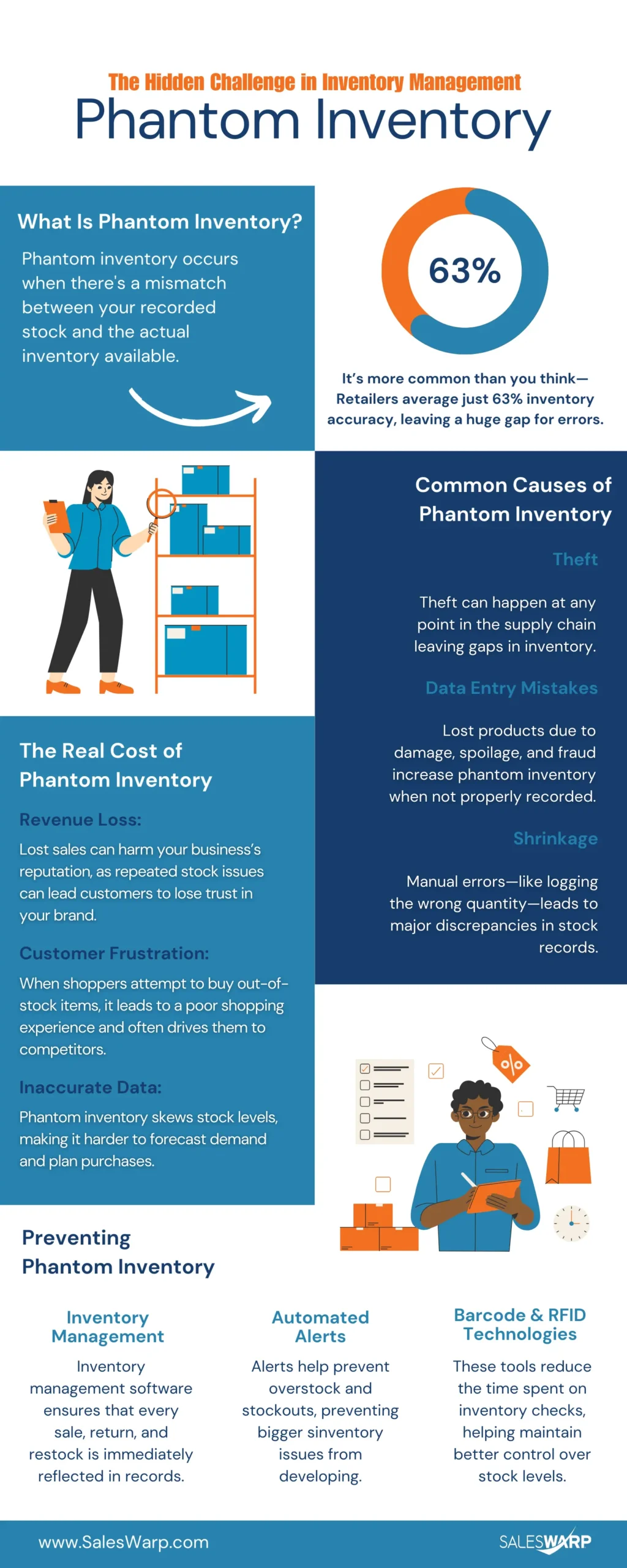Mitigating Phantom Inventory with Technology
What is Phantom Inventory?
Phantom inventory is a common issue in inventory management, where there’s a mismatch between the recorded inventory and the actual physical stock. The average U.S. retail operation has an inventory accuracy of only 63 percent. These discrepancies can stem from various sources, including data entry errors, or flaws in inventory management systems. Phantom inventory can disrupt operations, causing inaccurate stock counts, delays in order fulfillment, and reduced overall efficiency.
Common Causes of Phantom Inventory
Theft: Inventory theft can happen at multiple stages, from the supply chain to the retail floor. Missing items due to theft create discrepancies between the physical inventory and what’s recorded in the system. Regular security checks and inventory audits are key to minimizing this risk.
Shrinkage: Shrinkage occurs when inventory is lost due to damage, spoilage, or administrative errors. It can also arise from supplier fraud. Without proper accounting for shrinkage, inventory records become unreliable, leading to phantom inventory.
Misplaced Items: Poorly organized storage or lack of proper labeling can result in misplaced items within a warehouse or retail space. These misplaced goods may be marked as in stock but are not physically where they should be, contributing to inventory inaccuracies.
Data Entry Mistakes: Manual entry mistakes are a frequent source of phantom inventory. These errors might occur during inventory updates, order processing, or other data-handling tasks. Inadequate training or complex procedures often exacerbate these mistakes.
Receiving Errors: Errors during the receiving process, such as incorrect quantities being recorded or the wrong items being received, can also create phantom inventory. Ensuring that received goods are thoroughly checked and accurately recorded is crucial to avoiding these discrepancies.
The Consequences of Phantom Inventory
Phantom inventory isn’t just a minor annoyance—it can have serious implications for your business, affecting both operations and customer relationships. Here are some of the key impacts:
Revenue Loss: When inventory records are incorrect, it can lead to missed sales opportunities. For instance, if a product is listed as available online but is actually out of stock, businesses may lose potential revenue. The inability to fulfill orders due to phantom inventory can damage a company’s reputation and result in even more lost sales.
Customer Experience: Customer satisfaction largely depends on product availability. When customers discover that an “in stock” item stock is actually unavailable, it can lead to frustration. If customers frequently encounter out-of-stock items that are listed as available, their frustration could lead them to shop elsewhere, damaging customer loyalty and retention.
Inaccurate Data: Accurate inventory data is essential for effective decision-making. Phantom inventory skews sales and inventory records, making it difficult to manage stock levels, forecast demand, and plan for future purchases. It can also complicate financial reporting and auditing.
How To Identify & Prevent Phantom Inventory?
Phantom inventory requires a proactive approach. By leveraging advanced systems like SalesWarp, businesses can gain real-time visibility into stock levels, automate essential functions, and reduce human error. Key features and benefits of utilizing inventory management software include:
- Implement Real-Time Inventory Tracking: Using modern inventory management software can provide real-time tracking of stock levels. This technology helps prevent discrepancies by ensuring that inventory records are updated continuously, reflecting the true stock status at all times.
- Utilize Automated Alerts and Notifications: Set up automated notifications to alert you when stock levels fall below or exceed certain thresholds. These alerts help prevent both stockouts and overstock situations, ensuring your inventory levels are accurate and manageable.
- Invest in Comprehensive Reporting and Analytics: Detailed reports and analytics generated by inventory management systems can help you identify trends, discrepancies, and potential issues.
- Reduce Manual Processes: By automating data entry and inventory updates, you can significantly reduce the likelihood of human errors. Automation ensures that your inventory records are more precise and reduces the chance of discrepancies leading to phantom inventory.
- Enhance Efficiency with Barcode and RFID Technologies: Incorporating barcode scanning and RFID technologies into your inventory management process can further streamline operations. These tools improve the accuracy of stock tracking and reduce the time spent on manual inventory checks.
Phantom inventory can be a silent but costly problem, leading to revenue loss, poor customer satisfaction, and inaccurate data. However, by understanding its causes and implementing inventory management, brands can prevent these discrepancies and maintain smooth operations.
Schedule a free demo and learn how SalesWarp can improve inventory visibility in your warehouse!


